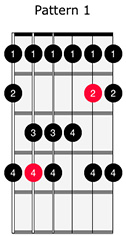Lead 301 - Major Scale Shapes

By this time, you should be very comfortable with the major pentatonic scale and should view the major scale as an extension of the pentatonic scale. The major scale incorporates the 4th and 7th degrees, which are the half-steps which were removed to get the pentatonic scale. If you remember, the formula for a major scale is:
Whole - Whole - Half - Whole - Whole - Whole - Half
Or these intervals:
1 2 3 4 5 6 7
Below are the five patterns of the major scale. Memorize them and play them the same way you did the pentatonics. Connect all of them up and down the neck in a variety of different keys.
Start by playing the lowest playable octave shape, then the chord, then the corresponding arpeggio, the pentatonic scale, and then the full major scale.
Finally, practice playing in each pattern over a one chord vamp and try to get the feel of each pattern with the addition of the half steps. Connect the patterns and get comfortable seeing the whole neck as a major scale.
Jamtracks:
1. C major vamp
2. G major vamp
3. D major vamp




